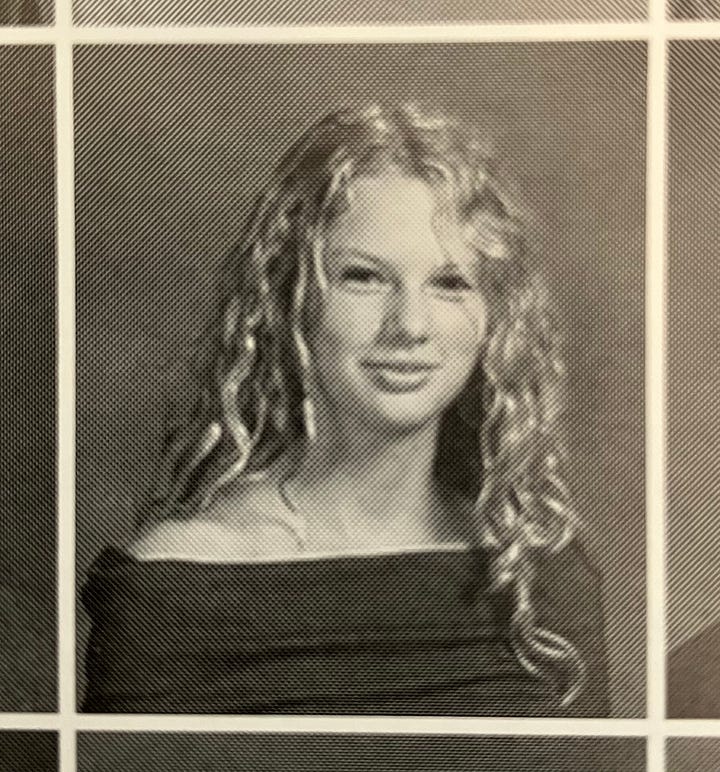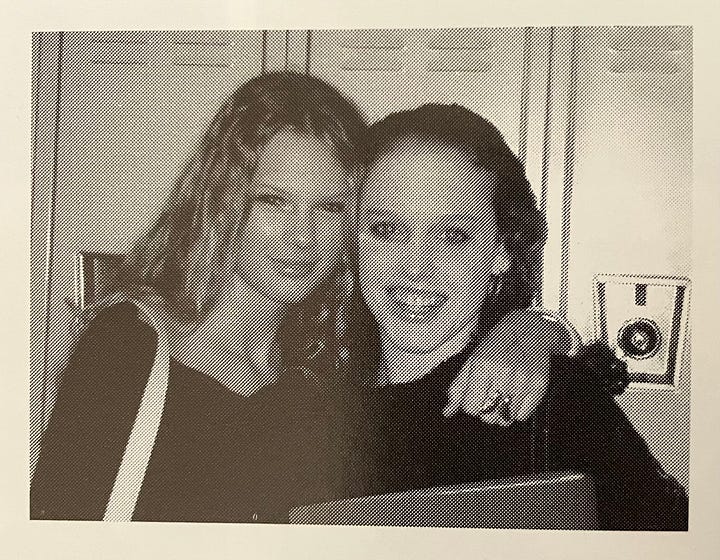Here we are in part 5 of my series of posts about Taylor Swift, and it perhaps goes without saying that I’m fascinated by Taylor. Much of the fascination has to do with the cultural phenomenon she has become. How did all of this happen — the record-breaking tours, the influence she holds,1 the ways she has changed the music business2, the amount of colleges offering courses about her work3? And when it comes to the teens in our youth groups, what makes them so drawn to her?
Honestly, the root of all of this goes back to high school for me, though. Because I went to high school with Taylor Swift.4 She was two grades behind me, and I remember her performing an original song in the school-wide talent show her freshman year. Her song seemed catchy, but I never thought she would make it big (despite a classmate telling me that Taylor had an agent who thought she would be “the next Britney Spears”). In our Nashville suburb, our talent shows were full of immense musical talent — she wasn’t even the best performer there by any stretch of the imagination.




So for me, these questions aren’t just about how any celebrity gets big and becomes a cultural phenomenon. It’s about… how did this girl that I used to walk the halls of my high school with seem to take over the world? How did her songs about people I used to ride the school bus with become the songs that I heard rooms full of middle school students scream-singing just a handful of years later? She’s just… a person. In my experience, it’s not just that she seems like a normal person — she is one!
So what’s behind the phenomenon of a teenager’s obsession with her? I can recall several times throughout my career in youth ministry when I noticed teens seem, well, overly connected to celebrities. The day in 2015 that Zayn left One Direction and students were telling me about girls checking out of school because they couldn’t handle it emotionally comes to mind. Then there are also the tears and hysteria surrounding attendance at a Taylor Swift concert. One teen, in that concert euphoria, shared that she texted her therapist, “I am cured.” Of course, she wasn’t actually cured of her mental health struggles, but in that moment at the concert, something felt different.
There are so many factors behind it. Taylor’s relatable lyrics, her sharing of intimate details of her life, and her seeming accessibility and “normalness” can make fans feel more connected with both Taylor and other fans, and these things certainly contribute. And the experience of being physically close to someone you idolize also often leads to feelings of euphoria during concerts — that “oh my gosh that’s really her and I’m really here in her presence!” feeling. We’d not be wrong to identify that as a type of worship.
One other factor for teens is their stage of development. Dan Siegel, the neuropsychiatrist and author known for developing the field of interpersonal neurobiology, talks about the adolescent years as a period of brain re-wiring that sets up teens’ minds with four qualities: novelty seeking, social engagement, increased emotional intensity, and creative exploration, each of which comes with benefits and risks.5 Therefore, teens seek out new things, new connections with peers they relate to, and ways to creatively express themselves, and they have heightened emotional responses to all of these things.
These are marks of their stage of brain development. They are probably part of the reason why everyone maintains a strong affinity for the music they listened to during their high school years. And they sound a lot like the kind of things going on when teens feel connected to Taylor and her music and fellow Swifties.
God made us for worship. Part of him making us for worship includes making us with emotions. When emotions get stirred up, they can lead us to worship. Ideally, our emotions and worship would get stirred up and directed toward Jesus. It only makes sense, though, that, during a period of intensified emotions and seeking of novelty and connections, teens would end up finding their emotions get stirred up by someone like Taylor, leading them to worship her.
God also seems to have designed us to look up to others. We need others to mentor, pour into, and shape us. Older saints would ideally step into these places in teens’ lives. However, teens often feel like adults don’t understand them, while simultaneously feeling like the musicians and celebrities they look up to do get them and are relatable. I definitely had songs I liked in high school because, whether I would have been able to recognize and articulate this or not at the time, they were expressing things I was feeling.
Emotions matter, because they give us important information about things going on in our lives. But we also need people to mentor us in what to do with our emotions and the information they give us. Popular musicians are not the best mentors in these things, but they often take on this role for teens when teens lack mentors who understand their emotional experience.
What if we in the church could fill those spaces instead? As teens grow to be independent of their parents and are finding themselves in this time of great brain re-wiring, let’s fill those spaces and help them direct their worship to the one who deserves all of it.
For example, “Taylor Swift and Beyoncé Could Sway Gen Z Vote”
This is the rest of the story behind why the phrase “Taylor Swift is a gift” caught on with students at one of my youth groups. Not only were her lyrics relatable, but whenever I met new students, bringing up my connection with Taylor Swift was an amazing ice-breaker. Students who weren’t too sure about me would suddenly become very interested in talking with me so they could learn more about my experiences with Taylor.
Check out his book Brainstorm: The Power and Purpose of the Teenage Brain for more on this.



